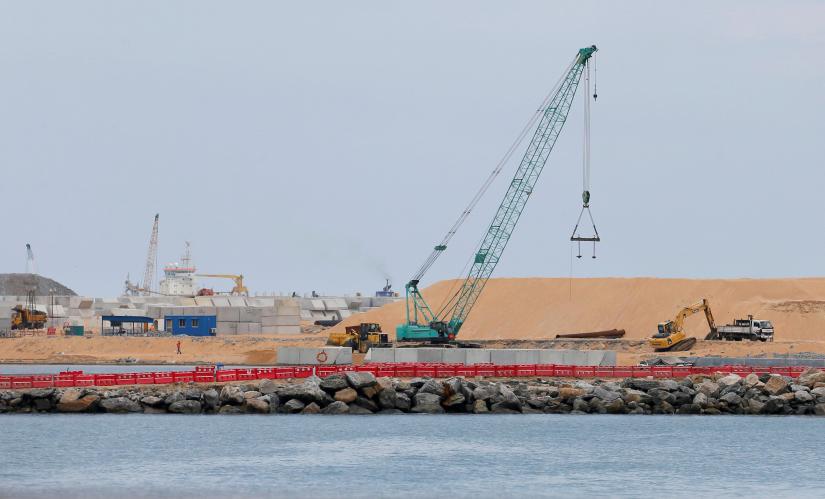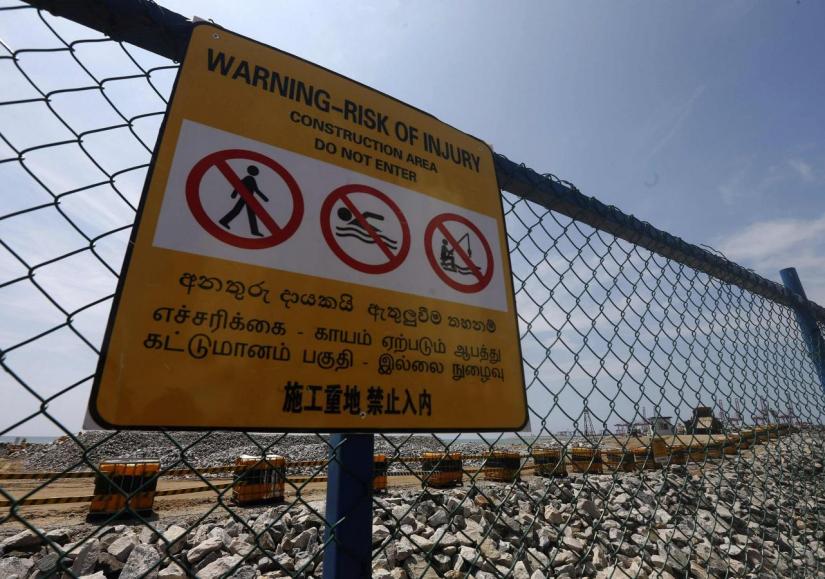 After Pakistan and Sri Lanka in South Asia, China has begun investing in a major way in Nepal in mega infra projects that are considered regionally important for its ambitious one-belt-one-road (OBOR) initiative. Wherever China approaches a smaller country to push its infrastructure-development agenda, much hype is generated about a’ win-win situation’ for both.
After Pakistan and Sri Lanka in South Asia, China has begun investing in a major way in Nepal in mega infra projects that are considered regionally important for its ambitious one-belt-one-road (OBOR) initiative. Wherever China approaches a smaller country to push its infrastructure-development agenda, much hype is generated about a’ win-win situation’ for both.
In recent years however, a body of evidence has been accumulated to suggest that such initial optimism is misplaced. As with most projects sponsored by an advanced country in any area, they are so structured that the long term benefits mostly go to the donor, not the recipients.
Pakistan and Sri Lanka, if recent developments there are any indication, are already paying a high price for the ‘help’ they have received from China. For Sri Lanka, the cost has been a loss of sovereignty over its Hambantota port for a century. For Pakistan, the price is being exacted in terms of loss of control over Baluchistan governance and social unrest. It is no different for Nepal. But for the moment the focus in this write-up will be mostly on Pakistan.
It is common knowledge how the $70 billion CPEC (China Pakistan economic Corridor) project has become the strongest pillar for the ailing Pak economy. Successive Pak Governments made over the years major concessions to China that, according to many Pakistani observers, impinged on its very sovereignty. Islamabad deployed over 15,000 troops to guard Chinese workers and their equipment as they worked on the CPEC highway in the turbulent Baluchistan areas. They had to suppress Baluchi protests against the CPEC projects which offered little benefit to the locals. The already poor Baluchis faced only further displacement with or without much compensation and fresh immiseration.
Despite a sharp uptick in official repression and assaults against the Baluchis, targeted sabotage and isolated attacks against the China-backed project continued to occur. The persistent Baluchi resistance led to human casualties, delays and material losses.
Initially the Chinese pressured Pak authorities to crush all local protests, but there was no progress. Then the Chinese changed tack and resorted to back channel diplomacy, without keeping Islamabad on board. Much to the chagrin of the Pak establishment, Chinese authorities decided to negotiate matters directly with local Baluchi leaders in some areas, without reference to Islamabad.
More worryingly for Pakistan, there was an immediate improvement in the law and order situation in some parts of Baluchistan as the project was no longer targeted. The palpable change on the ground was worked out within 18 months or so. It was soon time for China to broach the possibility of its assisting local development projects for the Baluchis, something that the Punjabi-dominated Pak rulers had not thought of doing for 72 years!
The story does not end here. For Pakistan, the continuing negative socio-economic fallout from the CPEC projects has occurred in more sensitive areas of nationhood, already causing a massive hurt to Pakistani pride.
First, Pakistan cannot protest effectively against the oppression of Uyghur Muslims in the Xinjiang province of China, even as it sheds copious tears over the plight of Muslims in Kashmir or the excesses of Israel against Palestinians. Pakistan is not the only Muslim country to maintain a diplomatic silence over the Uyghurs. Saudi Arabian Sunnis do not bother much either. Even Turkey, the country regarded by Uyghurs as their spiritual/cultural home, has released a mildly worded protest against China. That is all. The organisation of Islamic countries has hardly been more active, beyond the issuance of protests. However this is not to suggest that there are no voices in Pakistan attacking the ruling establishment for what is seen as its’ opportunistic silence’ against Beijing’s handling of the Uyghur Muslims and their aspirations. There have been critical references in sections of the Pak media.
However this is not to suggest that there are no voices in Pakistan attacking the ruling establishment for what is seen as its’ opportunistic silence’ against Beijing’s handling of the Uyghur Muslims and their aspirations. There have been critical references in sections of the Pak media.
The second snub for Pakistan concerns the prestige of its women. In recent months, over the last two years, over 600 Pakistani women have left mostly for Xinjiang province, after marrying Chinese men who had come to Pakistan for the CPEC work. The information became available through social media, open source web information and other channels.
Apparently, most of these women were victims of illegal trafficking. There are horrendous descriptions of how they are being tortured and mistreated by their husbands, who are sexually exploiting them along with others. Many women from Gujranwala and adjacent areas were ‘married’ in this way. Some came from poor families, suggesting that economic reasons, as well as the failure of their parents to secure ‘good’ husbands locally could have limited the options for their guardians.
These disturbing accounts created such a stir that Pak authorities initially ordered an investigation into the matter. The issue was discussed with Chinese authorities, who issued a statement after some weeks.
However, it now seems that the probe has been called off midway, as Beijing applied pressure on Islamabad.
Relatives of the women concerned say that they had forwarded names, residence proof and other details to Pak authorities for follow-up action. But now the local police, officials and investigators seem to have developed cold feet. They are either avoiding or misbehaving with, the complainants. In private they concede that pressure had been brought to bear upon them ‘from the top’.
It does not seem that much more will be heard about the plight of the unfortunate Pakistani ’brides’ who had married Chinese men and workers in good faith.
Beijing has been forced to issue a statement to keep the situation under wraps. It has been officially stated that marriages involving Chinese individuals are meticulously recorded and monitored, so that there no possibility of sexual exploitation or any other mischief, let alone trafficking which is dealt with severely. Beijing ensures that issues concerned with marriages especially with foreigners do not create a larger problem for the Chinese society, or its public image.
Significantly, there are also similar recent instances of Chinese men marrying Viet Namese or Laotian women in this region, although not much is known about the social fallout of such mixed marriages.
As Pakistan has virtually ordered an unwritten clampdown on any reporting on the Sino-Pak marriages, the affected families contacted western media with details they collected from the women. Some agencies have acquired photographs of a few women who have narrated their tales of woe through messages sent on mobiles.
It remains to be seen how this extremely sensitive issue, which has deeply divided public opinion as well as society in general in Pakistan, pans out in the future. A Kolkata-based analyst sees this as ‘one of the many invisible and unforeseen costs that come with accepting foreign financial help and assistance,’ constituting a new learning experience for Islamabad.
A Kolkata-based journalist, Ashis Biswas has worked for the Hindustan Times, Ananda Bazar Patrika, The Hindu and the Outlook magazine during his long career. He has been based in New Delhi, Kolkata and the Northeast and worked in West Asia as well.
 International
International
41174 hour(s) 16 minute(s) ago ;
Morning 09:10 ; Saturday ; Jun 28, 2025
The invisible social costs of Chinese aid
Send
Ashish Biswas
Published : 04:00, Dec 11, 2019 | Updated : 04:00, Dec 11, 2019
Published : 04:00, Dec 11, 2019 | Updated : 04:00, Dec 11, 2019
0 ...0 ...
/hb/
Topics: Top StoriesExclusive
- KOICA donates medical supplies to BSMMU
- 5 more flights to take back British nationals to London
- Covid19: Rajarbagh, Mohammadpur worst affected
- Momen joins UN solidarity song over COVID-19 combat
- Covid-19: OIC to hold special meeting
- WFP begins food distribution in Cox’s Bazar
- WFP begins food distribution in Cox’s Bazar
- 290 return home to Australia
- Third charter flight for US citizens to return home
- Dhaka proposes to postpone D8 Summit
Unauthorized use of news, image, information, etc published by Bangla Tribune is punishable by copyright law. Appropriate legal steps will be taken by the management against any person or body that infringes those laws.
Bangla Tribune is one of the most revered online newspapers in Bangladesh, due to its reputation of neutral coverage and incisive analysis.
F R Tower, 8/C Panthapath, Shukrabad, Dhaka-1207 | Phone: 58151324; 58151326, Fax: 58151329 | Mob: 01730794527, 01730794528


